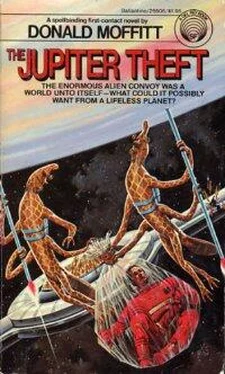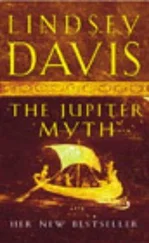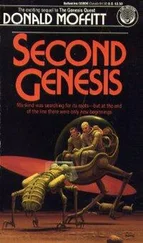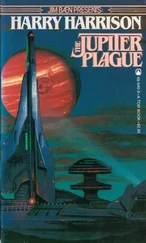The probe couldn’t be more than a few dozen meters in length. But its speed made it legion; it zipped around the planet like a horde of hydrogen-sucking vampires, bleeding Jupiter’s substance from the great continuous wound at the equator.
Faster and faster, squandering that bottomless reservoir of hydrogen to push itself fractionally close to the unattainable speed of light, this one tiny gnat could unpeel Jupiter layer by layer. Then, pregnant with stolen mass, it would reach a point on the curve where it outweighed Jupiter itself—or what was left of Jupiter.
Long before that point, Jupiter would begin to respond to its gravitational tug. The two bodies would be revolving around a common center of gravity, rising through Jupiter, then outside it. Some of the energy could be diverted to form a vector.
The giant planet would then follow the little robot ship like an elephant on a tether. The gigantic alien ships, in turn, would be drawn along in Jupiter’s wake, using its bulk as a convenient shield against the inferno of X-rays and gamma radiation sparking off the planet’s forward face.
Jameson scratched the stubble on his chin. The mysterious Earth-sized planet that the Cygnans had deposited in orbit around Jupiter was—he guessed—the discarded core of another gas giant. The sheer extravagance of it took his breath away. The Cygnans had to be the wastrels of the universe.
Maybe it was the only way to travel between the stars at relativistic speeds. Take along a gas giant for a fuel tank. Or, more accurately, have it take you along. A fuel supply—and protection against the hellish storm of radiation that happened when you collided with interstellar hydrogen at a speed approaching that of light.
The scale of it was staggering. But after all, he told himself reasonably, the principle wasn’t too different from that of an early chemical rocket burning tons of fuel to put a few pounds into orbit. As the fuel was burned up it imparted its energy to what was left of the payload—a point that had been lost on some of the early critics of space travel, who insisted that not even the most powerful known fuels contained enough energy to boost themselves to escape velocity.
His mind raced. Think of Jupiter, then, as being a series of fuel tanks which are progressively discarded as they are used up. The point at which the little probe gained enough mass to move Jupiter and Jupiter lost enough mass to be moved didn’t really matter; it could be expressed as a differential equation. Half a Jovian mass—or a tenth of it—was still plenty of mass left to play around with.
The Cygnans could afford to be profligate with their stolen planets. Suppose, Jameson thought feverishly, they burned 90 percent of Jupiter to attain a velocity of, say, 98 percent of the speed of light for their strange caravan. Ninety-eight percent, he guessed, would be about the point where a law of diminishing returns set in and the implacable equations of relativity demanded the expenditure of impossible amounts of energy to attain infinitesimal increments of velocity. So what? They’d coast at .98c. That would still leave them more than thirty Earth masses to brake with. Burning 90 percent of that would still leave them with three Earth masses at the end of their journey.
Be generous. Assume some inefficiency in their system. Surely they couldn’t totally convert matter to energy. Throw away a couple of Earth masses. That would still leave them with an Earth-sized rocky core.
Like the one that was now in orbit around Jupiter.
But wait a minute. Assume even more inefficiency!
Once they got going, they might pick up enough interstellar hydrogen to make up the difference. After all, why waste that manna of hydrogen infall as they plowed through interstellar gas clouds?
A twentieth-century scientist named Bussard once had calculated that an intake area of about 80 miles in diameter would be a sufficient-sized scoop for an interstellar ramjet feeding on clouds of ionized hydrogen. True, he was talking about a 1,000-ton spaceship, but he was also talking about ordinary hydrogen fusion.
Even at the final stages of their journey, with their Jovian giant shrunk to Earth size, they’d have a scoop with a diameter of 8,000 miles. And that was just the small end of a truncated cone—the impact area. The size of the large end would be anybody’s guess. It would depend on such things as gravitational attraction and the rate of ionization induced by the planet’s magnetic field. It could sweep an area hundreds of thousands of miles in diameter.
Jameson felt his cheeks burning with excitement. He wished he had Ruiz to talk this over with. Ruiz would be able to work out the math. But he was sure that he was right in his assumptions. It felt right! Hell, he could be wrong by a factor of ten and the principle would be the same. Burn 99 percent of a gas giant to get the remaining 1 percent—plus your piddling fifteen-mile ships—up to velocity. Then brake by burning 99 percent of the remaining 1 percent. Maybe they’d ridden here on a superjovian, ten or twenty times Jupiter’s mass. Maybe they’d have to limp out of the solar system at a mere 90 or 95 percent of the speed of light.
“The word is infinite,” Tetrachord said. He sounded like a cageful of twittering birds, all except the sound for “infinite,” which was a single sweeping glissando spanning two octaves, with a little turn at the top. Was it Jameson’s imagination, or was there an overtone of approval in the Cygnan’s voice, like a person patting a smart puppy on the head for doing a trick?
“But an infinite weight can never be reached,” Jameson responded quickly.
“No.” Again Jameson thought he heard approval. “But that-which-pulls will be heavy enough in…” There was a phrase for a unit of time.
That was the sticky point. The Cygnans, in their arrogance or self-sufficiency, had never bothered to give Jameson a scale involving Earth’s year or period of rotation. Perhaps they simply didn’t care to study the planets encountered during their transient pit stops. They used a Cygnan time scale, and to understand the timetable for this cosmic theft he was going to have to find out something about the Cygnan home planet. Perhaps it didn’t even exist any more, but it was still part of their cultural baggage.
Just how close to the speed of light could the little probe itself get in its flashing circuit, and how long would it take it to gain enough mass to move Jupiter? The probe didn’t have to accelerate any mass except itself; its fuel tank was external—Jupiter’s atmosphere. He frowned, trying to recall some of the theoretical scuttlebutt that had come out of the abandoned studies for a Centaurus probe. A twentieth-century rocket expert named Sanger had estimated that a respectable-sized spacecraft could attain 99.999,999,999,999,999,996 percent of the speed of light by annihilating a mass the size of the Moon. You could get there in a year at one g, in less than four days at 100 g’s.
The probe the Cygnans called “that-which-pulls” had been at it for more than six months. It must have brushed the speed of light within a few days. Now it was nibbling away at the remaining fraction, fighting an uphill battle against relativistic imperatives. The efficiency of its engines would be diminishing, from an outside observer’s viewpoint, by the penalty of an enormous time-dilation effect. But it was certainly getting there.
Now how the hell did the Cygnans keep the probe from flying off into space? At that speed, with its abnormal mass, and with its tight turns around Jupiter, the centrifugal force must be … unthinkable!
He was about to ask Tetrachord when he realized that the question was without meaning. What did it matter how much energy was diverted to tie the probe down in orbit? Just take whatever was needed out of all that kinetic energy stolen from Jupiter’s mass, no matter how mind-boggling the sum. Blow it out in a direction perpendicular to the orbit. Or change the attitude of the robot craft to provide a vector that would balance the enormous forces. The method didn’t even have to be particularly complicated. A simple feedback mechanism would do.
Читать дальше












